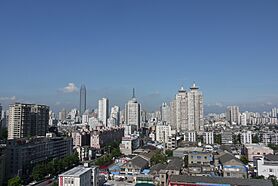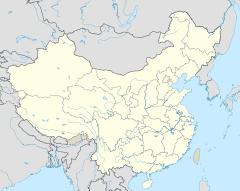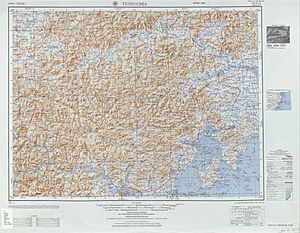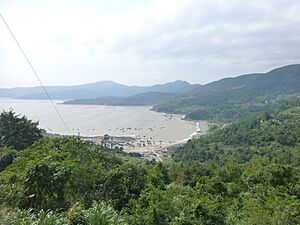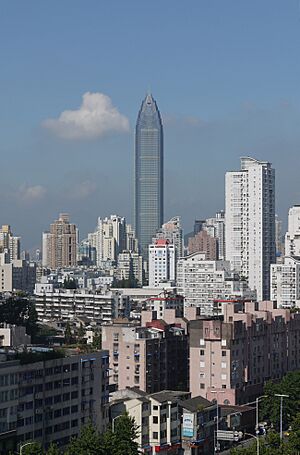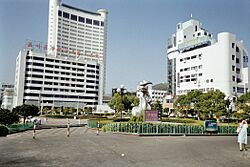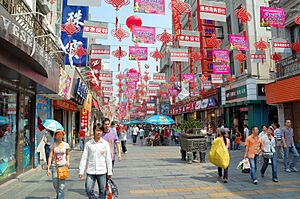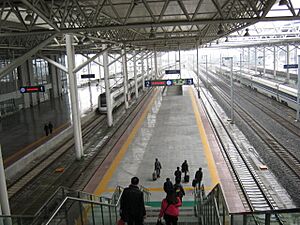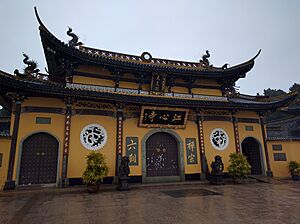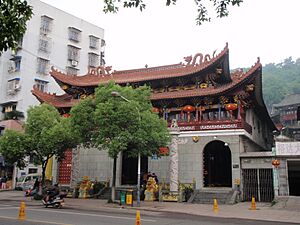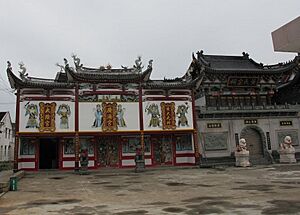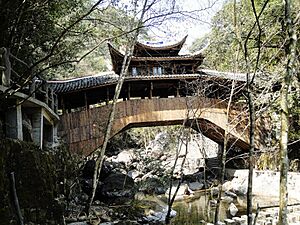Wenzhou facts for kids
Quick facts for kids
Wenzhou
温州市
Wenchow, Yujeu, Iu Tsiu, Dong Ou
|
|
|---|---|
|
Prefecture-level city
|
|
|
Left to right, top to bottom: City view of Wen, Wuma shopping street, the central city viewed from Bailuzhou Park, Pearl Beach, a suspension bridge in Taishun County.
|
|
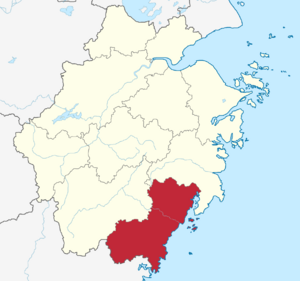
Location of Wenzhou City jurisdiction in Zhejiang
|
|
| Country | |
| Province | Zhejiang |
| County-level divisions | 9 |
| Municipal seat | Lucheng District |
| Area | |
| • Land | 12,255.74 km2 (4,731.97 sq mi) |
| • Urban | 1,243.4 km2 (480.1 sq mi) |
| Population
(2020 census)
|
|
| • Prefecture-level city | 9,572,903 |
| • Urban | 3,604,446 |
| • Urban density | 2,898.86/km2 (7,508.02/sq mi) |
| • Metro | 6,642,592 |
| • Rank in China | 15th |
| GDP | |
| • Prefecture-level city | CN¥ 873 billion US$ 121.4 billion |
| • Per capita | CN¥ 89,443 US$ 12,439 |
| Time zone | UTC+8 (China Standard) |
| Postal code |
325000
|
| Area code(s) | 0577 |
| ISO 3166 code | CN-ZJ-03 |
| License Plate | 浙C |
| Spoken language | Wenzhounese |
| Website | www.wenzhou.gov.cn |
| Wenzhou | |||||||||||||||||||||||||||||||||||||||||||||
|---|---|---|---|---|---|---|---|---|---|---|---|---|---|---|---|---|---|---|---|---|---|---|---|---|---|---|---|---|---|---|---|---|---|---|---|---|---|---|---|---|---|---|---|---|---|

"Wenzhou" in Simplified (top) and Traditional (bottom) Chinese characters
|
|||||||||||||||||||||||||||||||||||||||||||||
| Simplified Chinese | 温州 | ||||||||||||||||||||||||||||||||||||||||||||
| Traditional Chinese | 溫州 | ||||||||||||||||||||||||||||||||||||||||||||
| Wu | Iu1-ciou1 (Wenzhounese) Uen1tseu1 (Shanghainese) |
||||||||||||||||||||||||||||||||||||||||||||
| Postal | Wenchow | ||||||||||||||||||||||||||||||||||||||||||||
| Literal meaning | "Wen[qiao Mountains] Prefecture" | ||||||||||||||||||||||||||||||||||||||||||||
|
|||||||||||||||||||||||||||||||||||||||||||||
Wenzhou is a large city in Zhejiang province, China. It is located in the very southeast of Zhejiang. Wenzhou borders Lishui to the west, Taizhou to the north, and Fujian province to the south. The area is mostly mountainous. It also has hundreds of islands along the East China Sea coast, which is about 355 kilometers long. People say that 70% of the city's land is mountains, 20% is farmland, and 10% is water.
In 2010, about 3 million people lived in Wenzhou's main urban area. The larger Wenzhou region, which includes three smaller cities and six counties, had a total population of 9.1 million. About 31% of these people were originally from outside Wenzhou.
In the 1800s, Wenzhou was known as Yungkia. It was a busy port city where foreign ships could trade. Because it's surrounded by mountains, Wenzhou was quite isolated for a long time. This made its local culture and language, called Wenzhounese, very unique. Many people from Wenzhou have moved to Europe and the United States. They often become business owners, like restaurant owners or shopkeepers. For example, a large number of Chinese people in Italy are from Wenzhou. Many also live in New York City, France, and Spain.
Contents
- History of Wenzhou
- Fengshui and the City's Design
- Geography of Wenzhou
- Climate in Wenzhou
- City Administration
- Economy in Wenzhou
- Transport in Wenzhou
- Yongjia School of Thought
- Chinese Opera in Wenzhou
- Mathematics in Wenzhou
- "City of Chess"
- Culture and People
- Education in Wenzhou
- Notable People from Wenzhou
- See also
History of Wenzhou
Early Times
Archaeologists have found items in the Wenzhou area from around 2500 BC. Back then, it was known for making pottery and was one of the first places to create celadon (a type of green pottery) in ancient China. The Ouyue culture grew into the Kingdom of Dong'ou over 2,200 years ago. Because of its isolated mountains, the culture here often developed in its own way.
Imperial China's Influence
Around 200 BC, after the Qin dynasty ended, a leader from Wenzhou named Zou Yao helped Emperor Gaozu of Han defeat a powerful warlord. After this victory, Emperor Gaozu's son, Hui, made Zou Yao the king of the Dong'ou kingdom. Its new capital was near where Wenzhou is today. This kingdom lasted from 191 BC until it was taken over in 138 BC.
Wenzhou got its current name because of its mild weather. The city walls were built in the 900s, and its seven gates were put up in 1598.
Modern Changes
Historically, Wenzhou was an important port. It allowed goods to travel between the mountainous southern Zhejiang Province and the sea. In 1876, Wenzhou opened for tea exports. This led to many Wenzhounese merchants moving to France. During World War II (1937-1942), Wenzhou became one of the few ports still controlled by China. It became less important later in the war but recovered after coastal trade restarted in 1955.
Fengshui and the City's Design
Wenzhou is special because it's the only city in China designed by Guo Pu. He is known as the father of Fengshui, a Chinese philosophy. In the Jin Dynasty, Guo Pu used Fengshui ideas to plan Wenzhou. Fengshui is about how buildings and nature connect with "invisible forces" that link the universe, earth, and people.
People believe that Wenzhou's Fengshui design has protected it from many attacks throughout history. For example, during the Northern Song Dynasty, an army surrounded Wenzhou for over 40 days. But the mountains made it hard for them to move, and they eventually left.
Many people still think Wenzhou has the best Fengshui in China. Other cities like Beijing are also considered to have good Fengshui. However, Wenzhou is unique because it was designed entirely using Fengshui principles by Guo Pu himself. People often say the success of Wenzhounese people comes from the city's special Fengshui.
Guo Pu's Vision
When Guo Pu stood on West Guo Mountain, he saw that Wenzhou's mountains looked like a dipper (a scoop-like constellation). He also saw that the city itself looked like a key. Because of this, Wenzhou is still nicknamed the "Dipper city." There's a popular saying: "mountains as dipper, city as key."
Legend says that when Wenzhou was being built, a white deer with a flower in its mouth appeared in the city. This is why Wenzhou is also called "Deer City." Today, the downtown area is named Lucheng District, which means "Deer City District." There's even a popular White Deer theater there.
To honor Guo Pu, West Guo Mountain was renamed Guo Gong Mountain. A temple called Guo Gong Temple was built at its base. In 2003, a statue of Guo Pu was put up in downtown Wenzhou.
Geography of Wenzhou
Wenzhou covers a land area of about 11,784 square kilometers and a sea area of 11,000 square kilometers. It includes four districts, two county-level cities, and five counties. The total population of the city is 9.12 million, with 2.30 million living in urban areas.
Most of Wenzhou is mountainous. Many mountain peaks are over 1,000 meters high, like in the Yandang Mountains. This mountain range dominates the eastern part of the area. The Ou River is another important feature. It's the largest river in Wenzhou. There are also some flat coastal areas, especially around the mouth of the Ou River, where the city of Wenzhou is located. These flat areas are used a lot for farming and are home to many people and industries.
Wenzhou has a long coastline of 339 kilometers and many islands. Dongtou, one of Wenzhou's districts, is even called the "County of One Hundred Islands."
The city has beautiful landscapes with rugged mountains and calm waters. These include three national scenic spots: the Yandang Mountains, the Nanxi River, and the Baizhangji Fall-Feiyun Lake. There are also two national nature reserves: the Wuyanling Ridge and the Nanji Islands. Yandang Mountain is a World Geopark, and the Nanji Islands are a UNESCO Marine Nature Reserve. Scenic areas make up 25% of Wenzhou's land.
Climate in Wenzhou
Wenzhou gets its name from its mild climate. It has a humid subtropical climate with short winters and long, hot, humid summers. Summers are similar to the rest of the province, but winters are much milder. This is partly because Wenzhou is located further south and partly because the surrounding mountains protect it.
The average temperature ranges from 8.7°C in January to 28.7°C in July and August. The average temperature for the whole year is 18.9°C. Heavy rains happen in late spring and early summer due to the plum rains. Typhoons are also common in late summer, causing damage. Wenzhou gets about 1,706 hours of sunshine each year. The lowest temperature recorded since 1951 was -4.5°C, and the highest was 41.8°C.
| Climate data for Wenzhou (1991–2020 normals, extremes 1951–present) | |||||||||||||
|---|---|---|---|---|---|---|---|---|---|---|---|---|---|
| Month | Jan | Feb | Mar | Apr | May | Jun | Jul | Aug | Sep | Oct | Nov | Dec | Year |
| Record high °C (°F) | 25.6 (78.1) |
27.3 (81.1) |
29.5 (85.1) |
33.2 (91.8) |
35.7 (96.3) |
37.5 (99.5) |
41.7 (107.1) |
41.8 (107.2) |
38.0 (100.4) |
35.0 (95.0) |
30.0 (86.0) |
25.9 (78.6) |
41.8 (107.2) |
| Mean daily maximum °C (°F) | 12.9 (55.2) |
14.1 (57.4) |
17.1 (62.8) |
22.1 (71.8) |
26.2 (79.2) |
29.4 (84.9) |
33.3 (91.9) |
33.1 (91.6) |
30.1 (86.2) |
25.9 (78.6) |
20.8 (69.4) |
15.6 (60.1) |
23.4 (74.1) |
| Daily mean °C (°F) | 8.7 (47.7) |
9.7 (49.5) |
12.6 (54.7) |
17.3 (63.1) |
21.8 (71.2) |
25.2 (77.4) |
28.7 (83.7) |
28.5 (83.3) |
25.7 (78.3) |
21.2 (70.2) |
16.4 (61.5) |
11.0 (51.8) |
18.9 (66.0) |
| Mean daily minimum °C (°F) | 5.9 (42.6) |
6.8 (44.2) |
9.6 (49.3) |
14.1 (57.4) |
18.8 (65.8) |
22.5 (72.5) |
25.6 (78.1) |
25.5 (77.9) |
22.7 (72.9) |
17.9 (64.2) |
13.3 (55.9) |
7.9 (46.2) |
15.9 (60.6) |
| Record low °C (°F) | −4.5 (23.9) |
−3.9 (25.0) |
−1.7 (28.9) |
2.4 (36.3) |
9.0 (48.2) |
14.9 (58.8) |
17.9 (64.2) |
19.1 (66.4) |
13.7 (56.7) |
5.7 (42.3) |
0.2 (32.4) |
−3.5 (25.7) |
−4.5 (23.9) |
| Average precipitation mm (inches) | 65.3 (2.57) |
81.8 (3.22) |
146.3 (5.76) |
139.3 (5.48) |
178.3 (7.02) |
275.9 (10.86) |
186.3 (7.33) |
250.7 (9.87) |
211.1 (8.31) |
80.2 (3.16) |
77.1 (3.04) |
62.5 (2.46) |
1,754.8 (69.08) |
| Average precipitation days (≥ 0.1 mm) | 12.5 | 13.8 | 17.6 | 16.6 | 16.9 | 18.4 | 13.6 | 16.2 | 12.8 | 8.3 | 10.7 | 10.2 | 167.6 |
| Average snowy days | 1.0 | 0.8 | 0.2 | 0 | 0 | 0 | 0 | 0 | 0 | 0 | 0 | 0.3 | 2.3 |
| Average relative humidity (%) | 72 | 75 | 77 | 78 | 80 | 84 | 80 | 79 | 76 | 71 | 73 | 70 | 76 |
| Mean monthly sunshine hours | 94.4 | 90.7 | 99.2 | 118.1 | 121.0 | 111.5 | 193.8 | 183.4 | 149.7 | 146.6 | 110.7 | 103.4 | 1,522.5 |
| Percent possible sunshine | 29 | 29 | 27 | 31 | 29 | 27 | 46 | 46 | 41 | 41 | 35 | 32 | 34 |
| Source: China Meteorological Administrationall-time extreme temperature | |||||||||||||
City Administration
The city of Wenzhou is divided into four districts, three county-level cities, and five counties. Here's how its population was divided in the 2010 census:
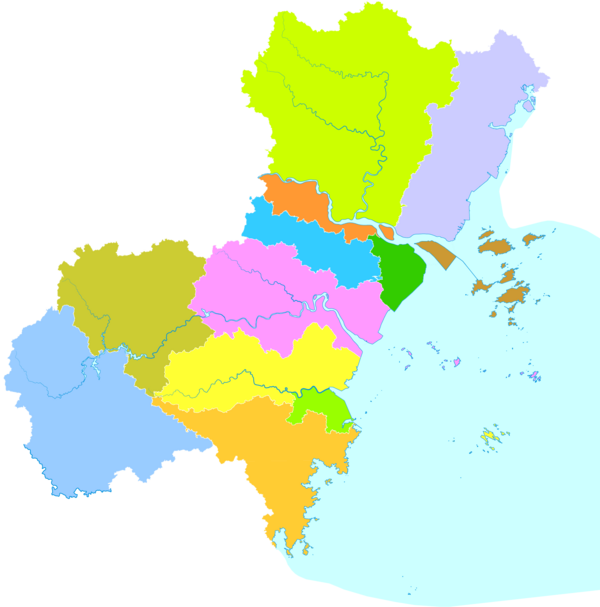
County
County
County
County
County
(city)
(city)
(city)
| # | Name | Type | Hanzi | Hanyu Pinyin | Population (2020 Census) |
Area(km2) | Density(/km2) |
|---|---|---|---|---|---|---|---|
| 1 | Lucheng District | District | 鹿城区 | Lùchéng Qū | 1,167,164 | 294.38 | 4,393 |
| 2 | Longwan District | District | 龙湾区 | Lóngwān Qū | 725,049 | 279 | 2,686 |
| 3 | Ouhai District | District | 瓯海区 | Ōuhǎi Qū | 963,238 | 614.5 | 1,622 |
| 4 | Dongtou District | District | 洞头区 | Dòngtóu Qū | 148,807 | 100 | 877 |
| 5 | Rui'an City | County-level city | 瑞安市 | Ruì'ān Shì | 1,520,046 | 1,271 | 1,121 |
| 6 | Yueqing City | County-level city | 乐清市 | Yuèqīng Shì | 1,453,090 | 1,174 | 1,183 |
| 7 | Longgang City | County-level city | 龙港市 | Lónggǎng Shì | 464,695 | 184 | 2,525 |
| 8 | Yongjia County | County | 永嘉县 | Yǒngjiā Xiàn | 869,548 | 2,674 | 295 |
| 9 | Pingyang County | County | 平阳县 | Píngyáng Xiàn | 863,166 | 1,042 | 731 |
| 10 | Cangnan County | County | 苍南县 | Cāngnán Xiàn | 843,959 | 1,088 | 931 |
| 11 | Wencheng County | County | 文成县 | Wénchéng Xiàn | 288,168 | 1,271 | 167 |
| 12 | Taishun County | County | 泰顺县 | Tàishùn Xiàn | 265,973 | 1,762 | 132 |
Economy in Wenzhou
Wenzhou exports many things, including food, tea, wine, and timber. It's also known for alunite, a mineral used to make alum and fertilizer. Wenzhou even calls itself the "Alunite Capital of the World."
The city has ten main industries that each earn over 1.5 billion dollars. These include electrical machinery, leather products, and textiles. Since the 1990s, making low-voltage electric appliances has become a major industry. Some large local companies have even partnered with big names like GE.
In 1994, companies started looking for oil and natural gas off the coast of Wenzhou in the East China Sea. However, these efforts haven't been very successful.
Wenzhou is a city full of business activity. When China started its economic reforms in 1978, Wenzhou was the first city to allow private businesses. It also led the way in changing its financial system. Wenzhou has achieved many "firsts" in China by using market ideas to develop its city.
From 1978 to 2016, Wenzhou's economy grew a lot. The money earned by people in rural areas increased from 113.5 RMB to 22,985 RMB. For city residents, it grew from 422.6 RMB in 1981 to 47,785 RMB in 2016. This is one of the highest incomes in China.
Financial Changes
In 2012, China's government chose Wenzhou for a special project. The goal was to make rules for private investments. Wenzhou had a lot of unofficial loans, and this project aimed to make these activities legal and regulated. It was seen as a way to clean up informal lending across China.
Birthplace of Private Business
In the early days of China's economic reforms, people from Wenzhou were leaders in starting private businesses. Many families began making products at home. Today, Wenzhou has over 240,000 individually owned businesses and 130,000 private companies. Some of these are very large, with a few even ranking among China's top 500 businesses.
Wenzhou is known as "China's Shoes Capital" and "China's Capital of Electrical Equipment." The way Wenzhou developed its private economy is called the "Wenzhou Economic Model." It has inspired other parts of China.
Wenzhou is a world leader in making lighters, with over 500 companies. The city's plastic weaving industry had 1,600 businesses in 2001. They employed 42,000 people and produced goods worth 20 billion Yuan. Wenzhou's lighter industry makes up 65% of China's market share and sells products to 60 countries.
People from Wenzhou also started China's first private airline, Juneyao Airlines, in 1991. The Jinwen Railway was the first railway built with private money.
Industrial Areas
Wenzhou Economic and Technological Development Zone
This zone was approved by the government in 1992. It's connected by major roads and is close to Wenzhou International Airport and Wenzhou Port. Industries here include electrical equipment, electronics, and textiles.
Wenzhou Oujiang River Estuary Industrial Zone
This zone is in the east of the city. It focuses on logistics, tourism, smart manufacturing, and information technology. There are also electronics and petrochemical industry businesses near the coast.
Oufei Project
In 2014, the Oufei Project started in Wenzhou. This project involves reclaiming land from the sea. The goal is to create 124 square kilometers of new land. This project aims to boost economic development and is one of the largest land reclamation projects in China.
Transport in Wenzhou
Air Travel
The Wenzhou Longwan International Airport serves the Wenzhou area. It has flights to major cities in mainland China, Hong Kong, and Macau. New direct flights to Taipei and Cheju Island (South Korea) started in 2012. The airport is about 20 kilometers southeast of the city. It's a Category B airport, serving about 20 million people from Wenzhou and nearby areas.
The airport opened in 1995. It connects Wenzhou to 65 cities with 34 regular flight routes. It's one of the fastest-growing and most profitable airports in China. In 2004, it handled 2.439 million passengers.
A new Terminal 2 opened on June 1, 2018, for all domestic flights. Terminal 1 now handles international and regional flights (to Hong Kong, Macau, and Taiwan). Terminal 2 has 21 boarding bridges and 52 check-in counters. This new terminal is a big step for Wenzhou's air travel.
Railway Travel
Building railways to Wenzhou has been difficult because of its mountains. Wenzhou's first railway, the Jinhua–Wenzhou railway, opened in 1998. It runs northwest to Jinhua. This railway was the first in China to be built with local private money.
In 2009, two high-speed railways opened in Wenzhou. The Ningbo–Taizhou–Wenzhou railway goes north to Hangzhou. The Wenzhou–Fuzhou railway goes south to Xiamen. These lines use high-speed trains that travel up to 200 km/h. They have greatly reduced travel times to nearby cities. The Jinhua–Wenzhou high-speed railway opened in 2015.
Lucheng District in Wenzhou was the location of China's only major high-speed rail accident.
City Transit
The Wenzhou Mass Transit Railway Investment Group was started in 2011. Its goal is to design, build, and operate Wenzhou's train system. This system will have regional lines (S-series) and local rapid transit lines. The S-Lines connect Wenzhou's counties and districts. The first line, Line S1, opened in 2019. Construction on Line S2 began in 2015. Plans are also being made for metro lines M1 and M2.
Yongjia School of Thought
The Yongjia School is a very important philosophical idea in China's history. It was one of the three most influential schools during the Song Dynasty. It has greatly shaped Chinese philosophy and Wenzhou's culture.
Key Ideas
The Yongjia School has four main ideas:
- It believes that doing things (practice) is more important than just thinking about ideas (theory).
- It suggests that being brave and honorable (chivalry) should go along with helping others (welfare).
- It supports combining farming (agriculture) with business (commerce).
- It stresses the importance of a strong military and a rich economy.
Market Economy and Business
The Yongjia School is perhaps the only major Chinese philosophy that focuses on currency, commerce, and private economy. Many scholars believe that the amazing economic prosperity during the Song Dynasty was due to the Yongjia School's influence.
Chinese Opera in Wenzhou
In the 1100s, during the Northern Song Dynasty, a type of opera called Nan Opera started in Wenzhou. It was also known as Wenzhou Opera or Yongjia Opera. This was the earliest form of traditional Chinese Opera. Nan Opera grew quickly because of Wenzhou's busy economy, which was influenced by the Yongjia School of Thought. As Wenzhou became a busy port, Nan Opera spread its influence across China. It became very popular in the Yuan Dynasty and remained important in the Ming Dynasty.
In the late Yuan Dynasty, Nan Opera became even more popular. Later, in the Ming Dynasty, the original Wenzhou style of opera, sung in Wenzhounese, changed. It was mostly replaced by the Kun Shan style. Nan Opera then slowly turned into a new form called chuanqi. This became a major type of drama in the Ming Dynasty.
Character Roles on Stage
In a Nan Opera performance, there are usually seven types of characters: Life, Denier, Ugliness, Clarity, Finale, Exterior, and Attachment. The main story usually revolves around the Life and Denier characters. This system of seven character roles, created in Wenzhou, was the first complete system for roles in Chinese Opera.
Four Miracles of the Yuan Dynasty
Even though Nan Opera was the first mature Chinese opera, officials in the early Yuan Dynasty often disliked it. They looked down on people from southern China.
Despite this, artists from Wenzhou kept developing Nan Drama. They created amazing works like "Jing Cha Tale" and "Bai Tu Tale." These were later called the "Four Miracles" of the Yuan Dynasty. Studies show that at least half of these "Miracles" were created entirely by Wenzhounese artists.
Tale of the Pipa
Tale of the Pipa (or Tale of Lute) was written by Gao Ming from Wenzhou. It shows the best qualities of Nan Opera during its most influential period in the mid-Yuan Dynasty.
This play is seen as a link between Nan Opera and the chuanqi style. Tale of the Pipa is one of the greatest achievements in Chinese Opera. It had a huge impact on how traditional Chinese opera was written. It's often called the "Ancestor of all Plays" in China, just as Nan drama is called the "Ancestor of all Operas." In the 1800s, Tale of the Pipa was translated into English, French, German, and Latin. It helped Westerners appreciate Chinese literature.
The first translation of Lute Song was published in Paris in 1841. In 1946, an American musical comedy based on Tale of the Pipa, called Lute Song, was performed on Broadway.
Nancy Reagan's Role
Tale of the Pipa was also the only Broadway play that Nancy Reagan, who later became the First Lady of the United States, appeared in. In the play, she changed her appearance to look like an "oriental girl."
Like other Nan Opera plays written by Wenzhounese artists, Lute Song is known for its complex language. This has made it challenging for international scholars to understand fully.
Four Forms of Nan Opera
After Nan Opera was created in Wenzhou in the 1100s, it quickly spread across China. In the Ming Dynasty, the original Nan Opera, sung in Wenzhounese, changed. It developed into four different forms, each sung with a different melody. Some scholars even say there were five forms.
The original Nan Opera led to four new forms in the Ming Dynasty: Haiyan Tone, Yuyao Tone, Kunshan Tone, and Yiyang Tone. Today, the most popular of these is Kun Opera, which came from the Kunshan Tone. Kun Opera is recognized by UNESCO as a Masterpiece of Oral and Intangible Heritage of Humanity since 2001.
Mathematics in Wenzhou
Wenzhou has a long and important history in mathematics. Many mathematical achievements in modern China were made by mathematicians and scholars from Wenzhou. In 1896, Sun Yirang, a Wenzhounese scholar, founded China's first mathematics academy, the Ruian Mathematics Academy, in Wenzhou. A year later, Huang Qingcheng, also from Wenzhou, started China's first mathematics magazine, "Journal of Arithmetic." In 1899, the "Ruian Heaven Calculation Association" was formed in Wenzhou. This was the first regional mathematics association in China's history.
A Hub for Mathematicians
Wenzhou is known as the "cradle of mathematicians" in the Greater China Region. Over the past 100 years, more than 200 mathematicians from Wenzhou have become famous both in China and worldwide. Reports show that in the 20th century, about one-fourth to one-third of the heads of mathematics departments in Chinese universities were from Wenzhou.
At a math conference in Beijing in 2002, mathematicians from around the world discussed "the large group of Wenzhounese mathematicians." They wanted to understand why so many great mathematicians came from Wenzhou. They also looked at how to encourage new mathematicians in the future. This is a very rare event in history, as Wenzhou has produced more mathematicians than any other city in the world.
In an interview, Su Buqing, a famous Wenzhounese mathematician, shared some interesting details. He told a writer that many math department heads in China were from Wenzhou. He even joked that at international math conferences, Wenzhounese was an unofficial second language! When asked if eating Large yellow croaker (a local fish) made people good at math, Su Buqing laughed. He said it was because Wenzhou was a poor area, and "it only takes the cost of a pencil to do math." So, many Wenzhounese people started studying math, and generations of mathematicians followed.
Jiang Lifu's Contributions
Jiang Lifu, a mathematician from Wenzhou, is often called the father of modern Chinese mathematics and a pioneer of geometry. He was the second person in modern China to get a PhD in mathematics and the first from Wenzhou. In 1920, he returned to China and started the Department of Mathematics at Nankai University. He was the only professor there for the first four years and was very strict with his students.
Jiang also helped Chinese students study mathematics abroad in the early 1900s. Shiing-Shen Chern, a very important mathematician, said that Jiang was "the foremost leader in the field of mathematics in China." Su Buqing added that Jiang's impact on Chinese mathematics was so great that "without him, mathematics in China would have been completely different."
Shiing-Shen Chern's Connection
In 2003, Shiing-Shen Chern visited Wenzhou. He was amazed by the large number of famous mathematicians from the city. He wrote five Chinese characters that mean "Home of Mathematicians." Chern had many close friends and colleagues from Wenzhou.
His first math teacher and mentor was Jiang Lifu, a Wenzhounese mathematician. Jiang founded the math department at Nankai University, where Chern studied. Chern said, "I specialize in geometry because of my professor in college, Dr. Jiang." He also noted that his basic math education was taught to him directly by Mr. Jiang.
Taiwan's High-Tech Industry
Shu Shien-Siu, a Wenzhounese mathematician, is known as the father of Taiwan's high-tech industry. This industry is now the biggest part of Taiwan's economy. When Siu was the Minister of Science and Technology from 1973 to 1980, he suggested building the Hsinchu Science and Industrial Park in 1976.
There was a debate about where to build the park. Some thought it should be in a different area to be closer to military research. But Shu Shien-Siu argued that the park needed creativity and private business power, not too much government or military influence. He also said that Hsinchu was a better location because it was near important universities like National Tsing Hua University and National Chiao Tung University. He wanted the park to be like Silicon Valley in the US, which is close to major universities.
Siu's decision in 1976 is highly praised today. He correctly predicted the best way to develop the park. Today, the Hsinchu Science and Industrial Park is often called the "Silicon Valley of the Orient."
Higher Education in Taiwan
In 1961, Shu Shien-Siu founded the Department of Mathematics at National Tsing Hua University, a top university in Taiwan. A year later, he started the Summer Mathematics Conference, the first math conference in Taiwan's history.
When Siu became president of the university in 1970, it was small. He worked to expand it, adding an engineering college and a nuclear science college. From 1971 to 1973, he hired 165 professors with doctoral degrees. He also focused on building new facilities like dorms and faculty housing.
By the time he left in 1975, the university had grown significantly. It had nine departments, three colleges, and 13 institutes. Its student population grew to over 2,200. In 1975, National Tsing Hua University ranked first in Taiwan for Mathematics, Physics, and Chemistry.
Siu was greatly influenced by the Yongjia School of Thought from Wenzhou. He believed in practicality over theory. He emphasized that students should interact with society more than just staying on campus. He famously said, "What we need the most are the practitioners, who directly involve, but not the theorists." This idea shaped the university and is still important to National Tsing Hua University today.
"City of Chess"
In 1995, Wenzhou was named the "City of Chess" by China Qiyuan, the official agency for board games in China. In 2020, Wenzhou celebrated its 25th anniversary of this title. The President of FIDE (the world chess organization) sent a letter praising Wenzhou for producing many talented chess players like Ye Rongguang, Zhu Chen, and Ding Liren.
Zhu Chen, Chess Champion
Zhu Chen, a chess grandmaster from Wenzhou, is the first and only chess player in the world to win all youth, junior, and adult world championships.
- In 1988, she won the World Girls Under 12 Championship.
- In 1994 and 1996, she won the World Girls Junior Chess Championship twice.
- In 2001, she won the World Women's Individual Championship.
In 2002, Zhu Chen defeated Ruslan Ponomariov, who was the World Chess Champion at the time. This made her the first and only female world champion in any competitive sport to defeat a male world champion. Zhu Chen is currently the treasurer and Vice President of FIDE.
Culture and People
Language of Wenzhou
People from Wenzhou speak a unique language called Wenzhounese. It's part of the Wu Chinese language family, like the languages spoken in Hangzhou and Shanghai. Because Wenzhou was isolated by mountains and had people from Fujian move there, Wenzhounese has changed a lot. It's very different from other nearby languages, even those in the same family.
Wenzhounese is so hard to understand that it was reportedly used as a secret code during the Second Sino-Japanese War and the Sino-Vietnamese War. Its grammar, words, and pronunciation are almost impossible for outsiders to learn.
There's a common saying in China that shows how difficult Wenzhounese is: "Fear not the Heavens, fear not the Earth, but fear the Wenzhou person speaking Wenzhounese."
Religion in Wenzhou
Most people in Wenzhou follow Chinese folk religion, like in other parts of China. Some people are non-religious. Buddhism, Taoism, and Christianity are also present in the city.
Before 1949, Wenzhou had 2,000 registered places of worship and 4,500 religious leaders. However, in 1958, the government declared Wenzhou an "atheistic zone," and during the Cultural Revolution (1966–1976), religious buildings were closed. Religion quickly revived in the 1980s. Today, there are more registered places of worship than before. As of 2015, the city had 8,569 folk religious temples and 3,961 places of worship for major religions like Buddhism and Christianity.
"China's Jerusalem"
Wenzhou has been a center for Christian missionaries for centuries. Before 1949, it had 115,000 Christians, which was more than one-tenth of all Christians in China at that time. Today, it remains an important Christian center. In 2006, it was reported that 15% to 20% of the city's population was Christian. By 2012, official data showed at least one million Christians, about 11% of the population. Because of its large Christian population, Wenzhou has been called the "Jerusalem of the East" or "China's Jerusalem."
In recent years, there have been some actions by local authorities regarding Christian churches. In 2014, reports said that many churches were demolished, and over 300 church crosses were removed. Later reports updated these numbers to over 200 churches destroyed and 2,000 crosses removed. The Chinese government stated these actions were due to violations of land-use rules, not religious persecution. However, human rights groups and news agencies have questioned this explanation. For example, the New York Times reported that government documents showed these demolitions were part of a plan to reduce the public visibility of Christianity in the area. The documents specifically mentioned removing crosses from buildings along highways. This policy has faced some resistance, and some Christian leaders who protested have been jailed.
Tourism in Wenzhou
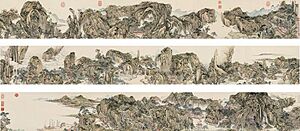
An essay by Zhu Ziqing about the beauty of Meiyu Pond and waterfall in the Middle Yandang Mountains is part of a reading test for Chinese language proficiency.
The Yandang Mountains, also known as Yandangshan Mountains, are over 120 million years old. They are famous for their natural beauty, with many tall rock faces, forests, streams, waterfalls, and caves.
The Nanxi River in Yongjia County is known for its 36 bends and 72 beaches. Key attractions include the Furong Triangle Rock, the Waterfall of Tengxi Pool, and the Lion Rock. It's a National Tourist Scenic Spot and is on UNESCO's Tentative Lists for World Heritage.
Taishun County has more than 900 covered bridges. The Wuyanling National Nature Reserve in the west of the county is also a beautiful natural area and a tourist spot.
Because of its diverse attractions, Wenzhou was chosen to host the 2016 Annual Convention of the Society for American Travel Writers. It beat out places like Israel and Texas.
Art and Literature
Wenzhou has a rich cultural history spanning over 1682 years. Many famous people and scholars have come from here. These include philosophers like Ye Shi, artists like Huang Gongwang, and scholars like Sun Yirang. They have all made important contributions to Chinese philosophy, literature, and science.
Wenzhou is also where Chinese landscape poetry began. Xie Lingyun, who started this style, was a leader in Wenzhou's Yongjia Prefecture. In the Song Dynasty, four famous poets from Yongjia represented the River and Lake Poetry.
Wenzhou is the birthplace of Nan Drama, which is the origin of all Chinese traditional drama forms, including Peking Opera. "The Romance of a Hairpin" is a well-known local story that inspires people who have faced difficulties but still believe in love. "Tale of Lute," a play by Gao Zecheng, is famous worldwide as one of the best Chinese dramas. Kun Opera, which came from Yongjia, is recognized by UNESCO as a human heritage.
Wenzhou is also known as the birthplace of China's private economy and its export-oriented industrialization. During the Southern Song Dynasty, the Yongjia School of Wenzhou, led by Ye Shi, emphasized the importance of business. This was different from the traditional Confucianism that focused on becoming officials. This idea has greatly influenced the people of Wenzhou and their business success.
Business Culture
Because Wenzhou was geographically isolated and lacked natural resources, the Chinese government allowed its people to be quite independent. Away from the main political and economic centers, Wenzhou people became very self-reliant and focused on business and family. Many books have been written about their business skills. When China changed to a capitalist economy in the late 1980s, Wenzhou people adapted well and took advantage of the new system.
A popular saying calls Wenzhounese people the "Jews of the Orient." They are sometimes seen by other Chinese as people who invest a lot in real estate. China Daily noted that Wenzhou buyers play a big role in increasing property prices across China.
People from Wenzhou are thought to have a strong business sense and a commercial culture. Wenzhou has two key economic features: it was the first to start a market economy, and it still has a very active and developed private economy.
Education in Wenzhou
Wenzhou has a large education sector, making up one-sixth of the total in Zhejiang Province. By the end of 2016, Wenzhou had 2,368 schools of different types, from pre-school to higher education. There were 1.48 million students and 127,200 teachers.
Higher Education
Most of Wenzhou's universities and colleges were established after 1949. Before that, there were no universities in Wenzhou; the highest level of education was senior high school.
There are three main universities in Wenzhou: Wenzhou University, Wenzhou Medical University, and Wenzhou-Kean University.
- Wenzhou University was formed by combining several colleges. Its main campus is in University Town.
- Wenzhou Medical University is famous worldwide for its eye care (ophthalmology) and other medical courses. Several of Wenzhou's major hospitals are connected to this university. The Wenzhou No.1 Affiliated Hospital is the largest in Asia by floor space.
- Wenzhou-Kean University was approved in 2011. It's one of the first universities in China run jointly with an American university.
University Websites
- Wenzhou University
- Wenzhou Medical University
- Wenzhou Business College
- Wenzhou Kean University
- Wenzhou Vocational & Technical College
- Zhejiang DongFang Vocationa & Technical College
- Zhejiang Industry and Trade Polytechnic
- Wenzhou Institute, University of Chinese Academy of Sciences
Notable People from Wenzhou
Mathematicians
- Sun Yirang (1848–1908): A pioneer in understanding ancient Chinese writing, he founded China's first math academy.
- Jiang Lifu (1890–1978): Known as the father of modern Chinese mathematics, he founded Nankai University's math department.
- Su Buqing (1902–2003): Called the "King of Math" in China, he was a famous geometer.
- Shu Shien-Siu (1912–2002): Considered the father of Taiwan's high-tech industry.
- Ky Fan (1914–2010): A prominent mathematician and professor at the University of California, Santa Barbara.
- Gu Chaohao (1926–2012): A former president of the University of Science and Technology of China.
- Wu-Chung Hsiang (born 1935): A very influential topologist and former head of the math department at Princeton University.
- Wu-Yi Hsiang (born 1937): A prominent geometer and professor emeritus at the University of California, Berkeley.
- Jiang Boju (born 1937): The first dean of the School of Mathematical Sciences at Peking University.
- T. Tony Cai (born 1967): A well-known statistician who won the COPSS Presidents' Award.
Go and Chess Players
- Xie Xiaxun (1888–1987): Known as the "Supreme Commander of Chess" in China.
- Ye Rongguang (born 1963): The first chess grandmaster in China's history.
- Zhu Chen (born 1976): The first person to win all youth, junior, and adult World Chess Championships.
- Ding Liren (born 1992): A chess grandmaster and the World Chess Champion in 2023.
University Presidents
- Huang Shaoqi (1854–1908): The first president and co-founder of Peking University.
- Su Buqing (1902–2003): Served as president of Fudan University.
- Shu Shien-Siu (1912–2002): President of National Tsing Hua University.
- Gu Chaohao (1926–2012): President of the University of Science and Technology of China.
- Wu Qidi (born 1947): Former vice prime minister of the Ministry of Education of China.
- Frank Shu (1943): Former president of the American Astronomical Society and National Tsing Hua University.
- Teng Jinguang (born 1964): President of Hong Kong Polytechnic University.
- Wu Zhaohui (born 1966): President of Zhejiang University.
Academics
- Wang Xizhi (303–361): A famous calligrapher, once governor of Yongjia (Wenzhou).
- Ye Shi (1150–1223): A philosopher and key figure of the Yongjia School.
- Xia Nai (1910–1985): A pioneer in archaeology in modern China.
- Chen Cheng-siang (1922–2003): A prominent geographer, sometimes called the "Alexander von Humboldt of the Orient."
- Chen Guangzhong (born 1930): A jurist known as the father of criminal procedure in China.
- Frank Shu (1943): A professor of astronomy at the University of California, Berkeley.
- Shen Zhixun (born 1962): A professor at Stanford University and a pioneer in materials physics.
Politicians
- Liu Ji (1311–1375): A great military strategist and statesman, a founding father of the Ming Dynasty.
- Chen Cheng (1897–1965): A former Vice President and Premier of the Republic of China.
- Jean Ping (born 1942): Former Chairperson of the Commission of the African Union.
- Li Qiang (born 1959): The current Premier of the People's Republic of China.
- Yi Huiman (born 1964): Chairman of the China Securities Regulatory Commission.
Businesspeople
- Nina Wang (1937–2007): A billionaire businesswoman, once Asia's richest woman.
- Jason Chang (born 1944): Founder and president of ASE Group, a large semiconductor manufacturing company.
- Nita Ing (born 1955): A business leader in Taiwan's construction industry.
- James Chu (born 1957): Founder and president of Viewsonic, a display technology company.
- Jen-Hsun Huang (born 1963): Co-founder, president, and CEO of Nvidia, a leading technology company.
Athletes
- Xia Xuanze (born 1979): A former badminton player and Olympic bronze medalist.
- Ho-Pin Tung (born 1982): The first Formula 1 racer from China.
- Zhu Qinan (born 1984): An Olympic gold medalist in sport shooting.
- Xu Jiayu (born 1995): An Olympic silver medalist and world champion swimmer in backstroke.
- Zheng Siwei (born 1997): A three-time World Champion and Olympic silver medalist in badminton mixed doubles.
- Pan Zhanle (born 2004): An Olympic gold medalist swimmer who holds the world record in the men's 100-meter freestyle.
Others
- Yongjia Xuanjue (655–713): A famous Chán master and Buddhist monk.
- Zeng Liansong (1917–1999): The designer of the Flag of the People's Republic of China.
- Nan Huai-Chin (1918–2012): A spiritual teacher and important figure in modern Chinese Buddhism.
- Wang Zhaofan (born 1931): An architect who helped design the original World Trade Center in New York.
- Zhou Yun (born 1978): A main actress in films like Let the Bullets Fly.
- Sui He (born 1989): A Victoria's Secret fashion model and the first Asian face of Shiseido.
- Winwin (Dong Si Cheng) (born 1997): A lead dancer in the K-pop group NCT (band).
- Cai Xukun (born 1998): A Chinese solo artist and former member of the C-pop group Nine Percent.
- Justin (singer, born 2002) (Huang Ming Hao) (born 2002): A former member of Nine Percent and current member of NEXT.
|
See also
 In Spanish: Wenzhou para niños
In Spanish: Wenzhou para niños


